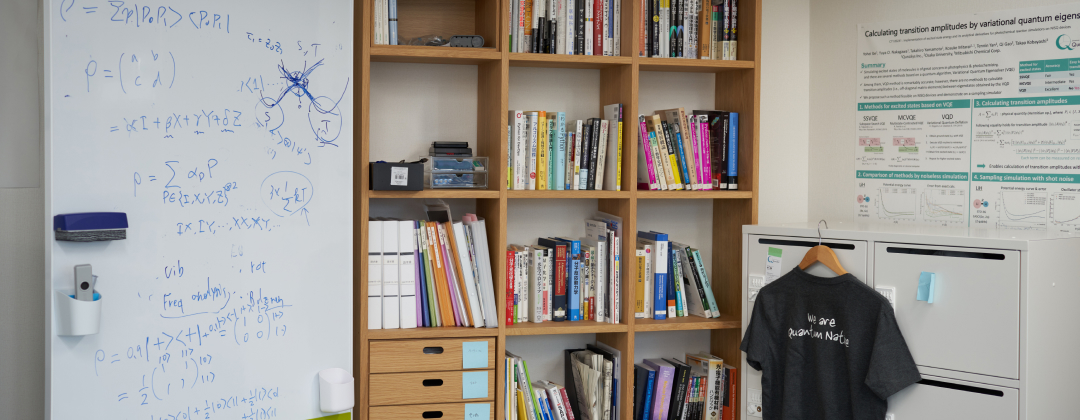
 QunaSys Tech Blog
QunaSys Tech Blog
Quantum Chemistry
Demonstration of quantum computation for molecular ground state energy by using the QSCI method
On December 4-6, 2023, we presented our joint research findings with ENEOS Corporation at IBM Quantum Summit 2023 held in New York. This article will introduce the content of our joint research.
Analytical gradient of energies with a sophisticated calculation method by quantum computers: application to the analysis of a photochemical reaction including conical intersection

Researchers at QunaSys Inc., Osaka University, and Mitsubishi Chemical Co. have developed an algorithm for calculating the gradient of energy of molecules with a method called state-averaged orbital-optimized variational quantum eigensolver (SA-OO-VQE), which gives a well-balanced description of multiple electronic states and expected to be utilized in a variety of quantum chemistry applications of quantum computers. They have applied the energy derivative calculated based on the developed method to the problem of determining the reaction pathway of cis-trans photoisomerization including a conical intersection, whose analysis requires a balanced description for the ground and excited states, with classical numerical simulation of quantum computers. The results were published in the Journal of Chemical Theory and Computation, a peer-reviewed journal of the American Chemical Society.
Accelerating variational quantum algorithms — A novel way to estimate expectation values on quantum computers
Estimation of expectation values is a key ingredient in variational quantum algorithms [1], regarded as promising candidates for industrial applications of near-term quantum computers. A challenge in the standard ways of expectation value estimation is the necessity to repeat measurement many times to suppress statistical fluctuation, especially in the application to quantum chemistry, which typically demands high accuracy. We proposed [2] an alternative method to estimate the expectation values, which can be more efficient for a certain type of quantum state, frequently encountered in systems of quantum chemistry and condensed matter physics.
Quantum machine learning of quantum data with NISQ devices — Learning wavefunctions of molecules in quantum chemistry
For some problems in physical science, we need to take care of quantum information to compute or simulate target physics because it is described by quantum mechanics. In most cases, however, it is hard to handle such quantum information on classical computers. Given that, it is natural to think of processing quantum information as it is by a quantum computer, like Feynman’s famous quote, “Nature isn’t classical, dammit, and if you want to make a simulation of nature, you’d better make it quantum mechanical”[1]. Today, we are witnessing the realization of prototypical digital quantum computers; quantum devices consisting of hundreds to thousands of non-fault tolerant qubits (quantum bits), the so-called noisy intermediate-scale quantum (NISQ) devices, have been developed rapidly in the past few years. Some commercial companies start providing access to their early-stage NISQ devices to their customers, although the devices seem still too small and noisy to execute any industrially-competitive tasks.
Calculating derivatives of molecular electronic energy on a quantum computer
While classical computers have bits representing either 0 or 1 values, quantum computers have qubits which provide arbitrary superposition of the bases \ket{0} and \ket{1} of quantum states. This intrinsic difference forms the powerfulness of quantum computers overwhelming classical computers. Though the quantum computer’s full potential is still in progress, we are now in the first stage where the so-called NISQ (Noisy Intermediate-Scale Quantum) devices are available. NISQ devices can operate only the limited number of algorithms for quantum computers, or quantum algorithms, because the error in their qubits prevents us from executing the complicated quantum algorithms. In the coming 3–5 years, we will need efficient quantum algorithms to explore the quantum advantage with NISQ devices having 50 to a few hundred qubits.
Comprehensive approach for resolving energy spectrum with symmetry using a quantum computer
“Symmetry” appears everywhere in modern physics, and it plays a significant role in understanding various properties of a quantum system. When a quantum system has symmetry, the energy spectrum/states of the system can be classified according to the symmetry; it is known that the symmetry introduces a conserved quantity C (an observable) in a quantum system, and an eigenvalue c of C stipulates a category of symmetry. It is demanding to predict what energies/states appear in each category of symmetry. In quantum chemistry, for example, it is known that light absorption and luminescence only occur among states residing in a certain symmetric category. Thus, to understand photochemical properties of molecules, it is essential to analyze the energies/states of the molecules based on their symmetry.
Testing important industrial problems with Honeywell’s Ion-Trap quantum computer — Calculating transition amplitudes of Azobenzene isomers using Honeywell System Model HØ
In June 2020, Honeywell became the first to commercially offer a quantum computer achieving a Quantum Volume of 64, with the launch of their System Model HØ. Following Honeywell’s announcement, we at QunaSys started thinking about what we could do with the world’s most powerful quantum computer?
Quantum algorithm for calculating electronically excited states of molecules — Subspace-Search Variational Quantum Eigensolver
Quantum chemistry aims to describe the behavior of atoms and molecules. Geometrical structures, molecular vibrational motions, chemical reaction dynamics, and photon absorption and emission are critical characteristics. A complete and accurate electronic structure is a prerequisite for obtaining that information accurately.